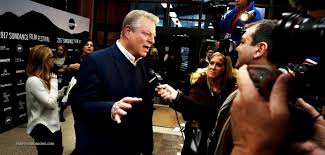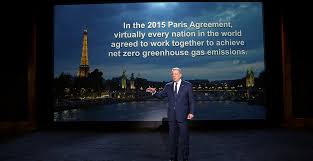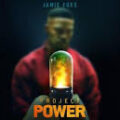
Former Vice President found a cause after losing the election to George Bush in 2000. He literally dove into the subject of climate change shown in the documentary, An Inconvenient Truth, he presented 10 years ago. Since that time, there have been changes that make it easier for countries to use solar and wind energy, but there have also been political ramifications keeping governments from changing over from using fossil fuels. This is what Gore presents in this sequel.
It shows both sides, but more important, it shows the human side of Al Gore and his relentless energy and passion for the subject. The filmmakers admit that you have to be in good shape to keep up with him.
Directors Bonni Cohen and Jon Shenk followed Gore around the world shooting his interaction with government leaders, but also detailed visuals of peoples struggling with the results of drought, flooding and more extreme weather patterns. They also show what has been done so far and what more can be done to fix it.
The first film was clinical with a lot of talking heads and graphs with statistics. It as not visually exciting. More like a slide lecture led by Gore, it was pretty dry. Although presenting valuable information it seemed to reach only those who already believed in global warming and climate change. It was playing to the choir.
But Cohen and Shenk followed Gore and shot dramatic examples of what he is now calling a “Climate Crisis.” You see glaciers melting at an alarming rate in Greenland, pollution in China and India that make it impossible to breathe, the spread of insects causing tropical diseases like the Zika virus which affect pregnant women, the typhoon in the Philippines that leveled towns and drowned so many of it’s citizens, plus flooding in Miami that stops normal everyday life and kills business which happens on a regular basis.



The film gets heavy into the politics of what’s in the way of using the solutions now available. You see Gore with his staff at the Paris Climate Conference in 2015 fighting for countries to recognize and commit help to solve the “Climate Crisis.”
One of the most surprising and dramatic sequences is coverage of the terrorist attack during the Conference and how it affected Gore, Paris and the meeting. It holds a mirror up to two of the world’s major problems that converged at the same time and place. The filmmakers do an excellent job following their subject and the people and police of Paris, allowing their emotional reactions to the attack to make an impact.
In a lighter vein, you also see Gore in Georgetown, the reddest city in the reddest county in Texas with Republican Mayor, Dale Ross. Ross is a CPA who ran the numbers and agreed that renewable energy is the way to go. The film shows the program he has put into place in his community and its benefits. Their amicable interaction captured between this jovial Mayor and Gore is fun, entertaining and one of the highlights of the film.
The filmmakers also show how even though there are setbacks, there is hope. He keeps trudging on with a positive attitude. You see him with people in Chile where their capacity for power from solar energy has far exceeded their expectations and they all get excited and emotional about it.
But the film makes it clear that it’s still a matter of convincing the world’s leaders to allot funds and push programs. Here in the United States, many cities and states have pledged to abide by the Paris Climate Accord, despite President Donald Trump’s stating this year his intention to withdraw.
One Republic provides the title song for the soundtrack of this film. Truth to Power is the title and the theme because Gore says the facts and solutions have to be accepted by world leaders to affect real change. If only Gore’s fans or believers see this film, Gore may lose again. In that case, he says, we may all lose.
Paramount Pictures 99 minutes PG









